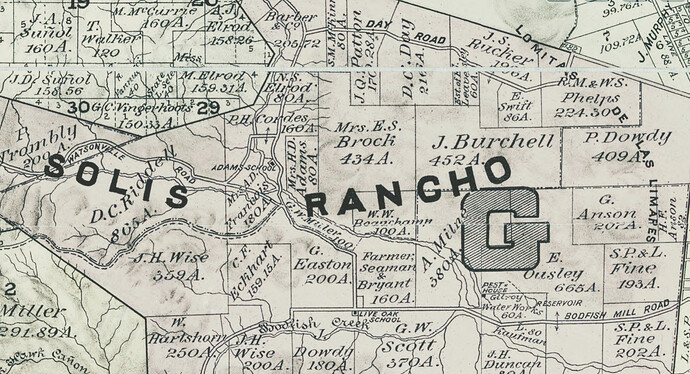The wine Kenneth Volk wine referred to in this thread and that older thread as Cabernet Pfeffer, Siletto Vineyard is the same block that became the Harrington Trousseau. Siletto says that there were some old vines called ‘Trousseau’ in the old El Gabilan Vineyard, and there are a few vines that look like Trousseau mixed into the old Cabernet Pfeffer at Enz. However, as the four old vineyards in the area exchanged budwood regularly, the fact that no other blocks exist on DeRose, Wirz or Enz makes me think that it’s the same massale selection. My impression is that the difference in the wines that Wes highlights has more to do with being on different sides of the San Andreas fault and the differences in soil, vine age and irrigation. I think the Harrington wine still bears strong markers of the variety, if not the same density and grit seen in the Cienega Valley versions.
The Cab Pfeffer name is just a placeholder. We’ll be doing more research into it’s genetic history this summer, but it looks like it is more of southeastern France origin (like Gros Verdot and Mourtaou) than via the Jura. It also looks like the genetic line might be lost in the old world and the remaining 8-10 acres in San Benito county plus a little budwood that has been sent out in the past two decades might be all there is. As best I can tell, the Gros Verdot was the closest match when Ken sent in samples but as the genetic database has improved, they’re getting a better match with Mourtaou, although that is only 96%, which is roughly the same genetic correspondence between humans and chimps.
Stories seem to line up with the genetic material coming through William Pfeffer’s nursery as he and Vache were tight. But we’re still trying to find out where it came from and if it dispersed to any other parts of the state.
That’s what I’ve gleaned in a couple years of digging. Hopefully the testing we do this summer in concert with the HVS will yield some better answers.
Pinot St. George (negrette) is different than St. George’s Pinot, which is actually Pinot Noir that is predominantly from a vineyard farmed by a guy named George, who is real nice. Cheeky.
Ian
Thanks for the input, Ian!!!
Probably an opportune time to share that when Ken Volk had the Enz Cab Pfeffer tested, he also had the block at Siletto tested. The samples showed they were essentially the same variety, which at that point Davis stated as Gros Verdot. They have since edited that to being 96% match to Mourtaou on the sample from Wirz, which matched the Cab Pfeffer in their database. I forgot about that little nugget of information… anyway, definitively not Trousseau no matter how you try to spin it. I’ll share when we get more information about what it definitively is, but it is a selection of something that has been referred to as Cabernet Pfeffer or Pfeffer Cabernet for better than 100 years, whatever the origin of the vines, and that’s the best name we have for now.
Every year Alfaro Family Vineyards and Winery offers a “Dragon Slayer Red”*, a value-priced (~$20/btl) blend composed of an ever-changing mix of old-vine grape varieties. While I have not tried any of them, the temptation to make a purchase is strong.
I sent an email to Mr Richard Alfaro to ask him about the vineyards included in the current vintage of the “Dragon Slayer Red”. I am including part of my message and his response.
My email:
"…Please let me know if you can help me understand a little bit more about your grape sources for the Alfaro Family ‘Dragon Slayer’ red wine. I have seen that the varieties and vineyards change from year to year. The current bottling’s data sheet lists:
• Sangiovese from ‘Gimelli Vineyards’, Cienega Valley;
• Zinfandel from ‘Adamo Vineyard’, Santa Clara County;
• Old Vine Carignan from ‘Rositano Vineyards’ Santa Clara County;
• Syrah from ‘Redwood Retreat Road Vineyards’, Santa Cruz Mountains.
"…I would like to think that I am fairly well versed on the vineyards of Redwood Retreat Rd. However, all I have found of ‘Rositano Vineyards’ is a possibility that the owner is related to Mr Gregory, but the address is wayon the eastern end of the road from the ‘Under the Mountain/Lion Oaks/Rusty Ridge Vineyard’. None of the ‘Rositano Vineyards’ (if my research is correct on the location) on Google Earth appear to be new, or at least not with visibly head-trained vines.
"I am assuming that the ‘Redwood Retreat Road Vineyards’ are the vines at Fernwood or somewhere nearby. That’s just my guess.
“I have not encountered ‘Adamo Vineyard’ in any of my research on the vineyards of Santa Clara County…”
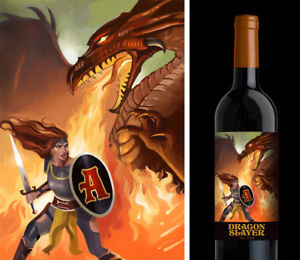
Mr Alfaro’s email response:
"Rositano Vineyard is the remains of a larger vineyard property that was broken up and developed into a housing project (Mc Mansions). Most of the homeowners pulled out the 130+ year old head trained vines and planted new vines (or other landscaping). It is off of Redwood Estates Rd. It is only a couple acres. I get all the fruit (10 barrels in 2017).
"The other grapes in [Alfaro Family] ‘Dragon Slayer’ are only around 20 years old.
The 2018 ‘Dragon Slayer’ will also have some of my ‘Gimelli’ Old Vine Zin from 1906. We also get fruit from ‘Bates Ranch’ (which is up for sale**).
Cheers,
Richard Alfaro
Alfaro Family Vineyards
420 Hames Rd.
Corralitos, CA 95076
831-728-5172
alfarowine.com"
Alfaro Family Vineyards and Winery website
\
** I didn’t know that the “Bates Ranch” was now on the market. IMHO, the vineyard’s increasing profile probably would boost the selling price.
I reached out to the folks at River Run a few weeks back. Here is the reply from JP at the winery:
"Hello: I don’t grow grapes but appreciate good Carignane and Mouvedre. I made ‘Wirz’ Carignane for about 10 years for my Rhone blend. I vineyard designated the '96 and it got ‘best red wine’ in Los Angles. The judges ordered 6 cases, remarking that finally someone made vineyard-designate.
"It took over 2 years to sell the 150 cases at $11. Nobody would believe Carignane could be a great wine. So good on you and drink up.
"As far I remember there is an OLD Carignane vyd of some acres - aproximately 4 miles east of 101 in Gilroy on 10th. Some old chicken sheds.
“Good luck.
JP”
I am trying to get more information from the crew at River Run (before the gate closes for good) for the “Carignan Renaissance Part Deux” thread.
River Run Winery website
UC ANR - IPM: Weather & Climate Observation Centers for Santa Clara & San Benito Counties
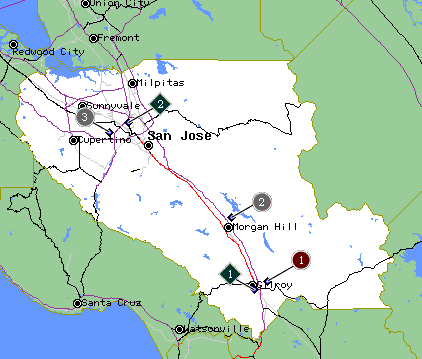
Santa Clara County Weather Stations
“Description of Gilroy.A (CIMIS #211, Gilroy)”
“Network:
CIMIS — California Irrigation Management Information System
Observer
Syngenta Seeds Inc.
Location
Holsclaw Road near Gilman Road
County: Santa Clara
Nearest City: Gilroy
Latitude: 37 deg 01 min N
Longitude: 121 deg 32 min W Elevation: 185 ft
Station and site characteristics
• Ground cover: Irrigated Turf
Available data
• UC IPM database records begin/end: September 1, 2009 / on-going
• Reporting interval: Daily
Stored variables:
• Air Temperature, max/min: Daily max/min measured at 1.5 m (4.92 ft).
• Evapotranspiration: Calculated from CIMIS hourly values.
• Precipitation: Daily total measured in a 20 cm (8 in) diameter gauge.
• Relative Humidity, max/min: Daily max/min relative humidity measured at 1.5 m (4.92 ft).
• Soil Temperature, max/min: Daily max/min measured at a 15 cm (6 in) depth.
• Solar Radiation: Daily global radiation measured by Licor pyranometer at 2 m (6.5 ft).
• Wind Speed/Direction, average: Daily average measured at 2 m (6.5 ft).”
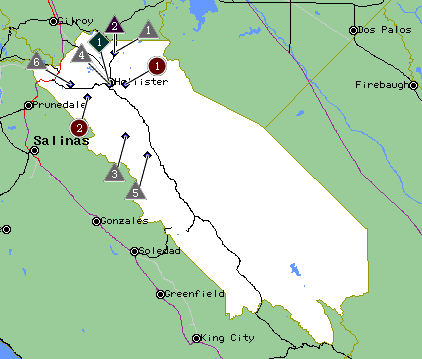
San Benito County Weather Stations*
“Description of HOLLISTR.C (NCDC #4025, Hollister 2)”
“Observer
HOLLISTER WATER DEPARTMENT
Location
County: San Benito
Nearest City: Hollister
Latitude: 36 deg 51 min N
Longitude: 121 deg 24 min W
Elevation: 275 ft
Station and site characteristics
Available data
• UC IPM database records begin/end: January 1, 1951 / about six months ago
• Reporting interval: Daily
Stored variables:
• Air Temperature, max/min: Daily max/min measured at 5 feet.
• Air Temperature at observation time:
• Precipitation: Daily total measured in 8 inch diameter gauge.
• Weather Type: Observer’s estimate of weather condition at observation time.
•Variables with computed averages: precip, air temp”
*** There appears to be a vast area of San Benito County that has no Weather/Climate Station…** ![]()
The following graphs and information are from the following unpublished book:
[u]A Statistical History of Wine Grape Acreage in California, 1856 - 1992[/u] (download)
by Ernest P. Peninou
Copyright 2000
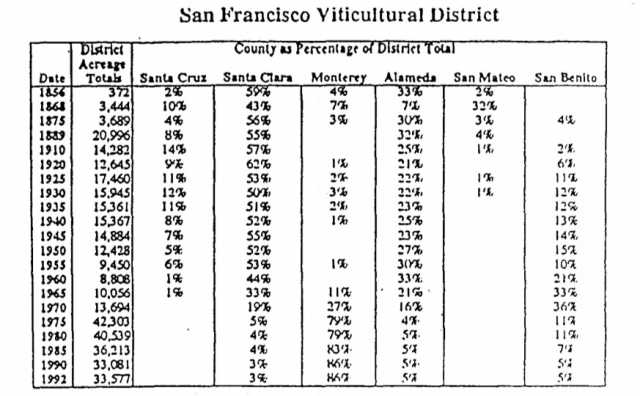
The peak year of wine grape acreage for Santa Clara County was 1920, with a total of 62% of the viticultural district’s 12,645 acres of grape growing land.
The peak year of wine grape acreage for San Benito County was 1970, with a total of 36% of the viticultural district’s 13,694 acres of grape growing land.
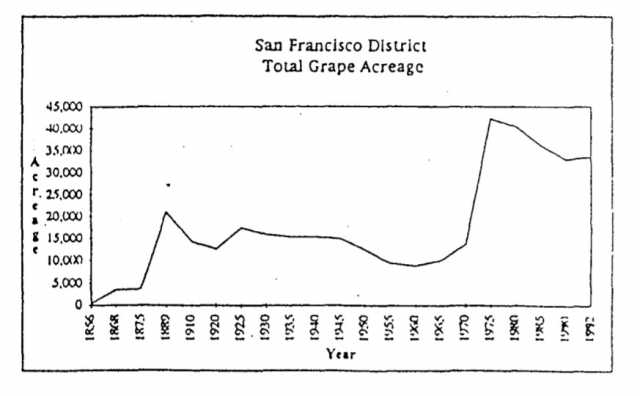
Around 1978, the entire Viticultural District had a total of just under 45,000 acres of land devoted to winegrape growing.
Wayward Tendrils website: “Downloadable Viticultural Histories”
Here are a couple of additional graphs from Ernest Peninou’s unpublished work:
[u]A Statistical History of Wine Grape Acreage in California, 1856 - 1992[/u] (download)
by Ernest P. Peninou
Copyright 2000
San Benito County: “Total Winegrape Acreage (1873-1992)”
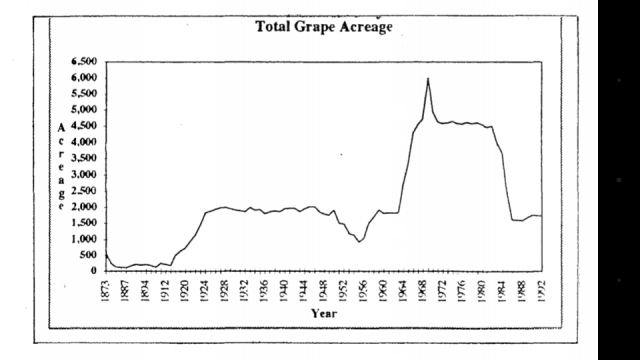
I believe that the increase in land planted to vineyards increased in San Benito County almost single-handedly due to the “Almaden Vineyard”. I certainly could be wrong about that, however.
Santa Clara County: “Total Winegrape Acreage (1873-1992)”
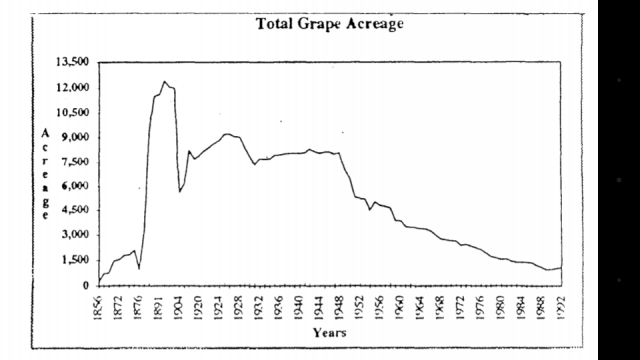
The marked decrease in vineyard land in Santa Clara County is probably because of commercial and residential development, most recently expedited due to the Silicon Valley boom.
Apologies for the poor quality of my screenshots.
Wayward Tendrils website: “Downloadable Viticultural Histories”
Gilroy Dispatch
“Sarah’s Vineyard to Celebrate 40 years: Release Anniversary Chardonnay in May”
by Gilroy Dispatch Staff
March 22, 2018
"Sarah’s Vineyard, founded in 1978 by a group of four wine enthusiasts led by Marilyn ‘Sarah’ Otteman, will celebrate its 40th anniversary this year with a May release of its ‘Estate Chardonnay’, according to a March 15 announcement.
"Throughout 2018, Sarah’s Vineyard, on Hecker Pass Road west of Gilroy, will be paying homage to its four decades of exceptional wines and hospitality.
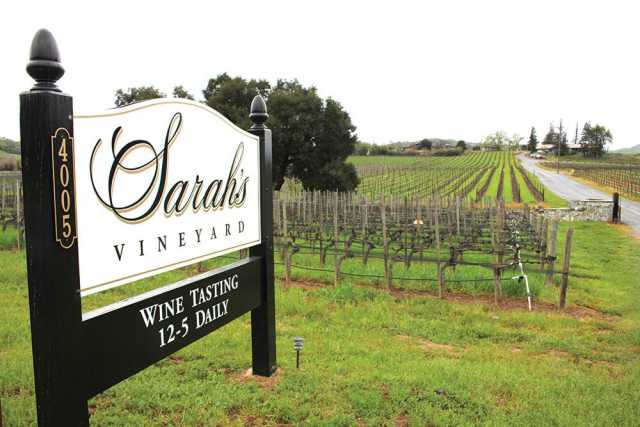
"On Thursday, May 10, Sarah’s Vineyard will release the new vintage of its ‘Estate’ Chardonnay, specially designated as the winery’s official 40th anniversary bottling.
“‘Sarah’s Vineyard became famous early on for the quality of its Chardonnay; naming the Estate Chardonnay as our anniversary wine honors both the past and the future of Sarah’s,’ said proprietor and winemaker Tim Slater…"[/i]
Sarah’s Vineyard website
Library of Congress website
“Official Map of the County of Santa Clara, California : Compiled from U.S. Surveys, County Records, and Private Surveys and the Tax-List of 1889, by Order of the Hon. Board of Supervisors”
Published by Herrmann Bros., 1890
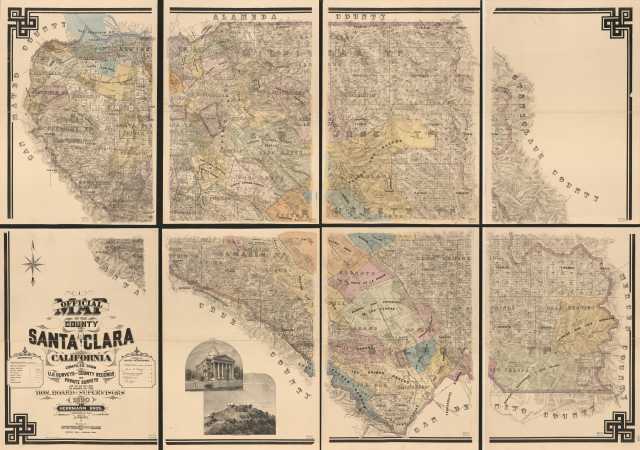
"Description:
"Relief shown by shading and spot heights. Cadastral map showing drainage, roads, railroads, ranchos, land ownership, landowners’ names, township ’ section lines, political townships, school districts, school houses, etc. Includes photographs of ‘Court House at San Jose’ and ‘Lick Observatory, Mt. Hamilton.’
“LC Land Ownership Maps, 39 Available also through the Library of Congress Web site as a Raster Image”
LCCN Permalink:
https://lccn.loc.gov/2012592102
*** EDIT ***
Rare Maps
“Plat of the Area Around Gilroy, California”
Published by Thompson & West (1876)
- excerpt from “Historical Atlas Map of Santa Clara County, California: Compiled, Drawn and Published from Personal Examinations and Surveys by Thompson & West, San Francisco”
Google Books
Directory of the Grape Growers…
California Board of State Viticultural Commissioners
AJ Johnson Supervisor (1891)
Internet Archive
California Revealed
Search Results: “Group of Abstracts of Title” (Deeds)
County of Santa Clara
Geographic Information Services
Santa Clara County Interactive Map Viewer
Santa Clara County Planning Office GIS Data
Interactive Santa Clara Planning Map
County of Santa Clara
Assessor website
County of Santa Clara Open Data Portal
County Map Books:
Maps
County of Santa Clara
County Archives website:
· Research And Collections
Online Databases
· Publications
Archives E-Newsletter
Santa Clara County Library District
Genealogy and Obituaries
Digital Reel
Santa Clara County Newspaper Archives
City of Watsonville
Online Newspapers: The Watsonville Historical Newspaper Archive
I want to give credit to the Berserker who brought my attention to this, but my brain fails me at the moment… ![]()
The DR Bennion Trust Fund’s website has existed for a good while, but it seems like only recently the page has been updated - but NOT completed. Technically, this is not under the purview of Santa Clara and San Benito Counties, but the content is SO GREAT* that it deserves a place on just about every thread!! ![]()
[u]Wines & Winemakers of the Santa Cruz Mountains: an Oral History (1992-1994)[/u]:
• “Table of Contents”
• “The Santa Cruz Area”
- Bargetto
- Hallcrest Vineyards
- Nicasio Vineyards
- Roudon-Smith Vineyards
- Devlin Wine Cellars
- Leo McCloskey
- Beauregard Ranch
- John Spezia
- Quistorf Ranch
• “The Highlands”
• “Saratoga Hills”
• “Monte Bello”
- Picchetti Ranch
- Sunrise Winery
- The Mikulaco Family
- Fellom Ranch Vineyards
- Ridge Vineyards
› Founding Partners:
° Elias (Lee) Carrasco
° Elmano Homem
° Paul Draper
› Ridge Wines & Documents
All links are PDF Image Downloads.
Special Thanks to the Berserker who informed me of the update!!!
These USGS web resources include file downloads for the geological feature maps of California’s Central Coast.
USGS website
“Open-File Report 94-231: Preliminary Quaternary Geologic Maps of Santa Clara Valley, Santa Clara, Alameda, and San Mateo Counties, California: A Digital Database”
by E.J. Helley, R.W. Graymer, G.A. Phelps, P.K. Showalter, and C.M. Wentworth (1994)
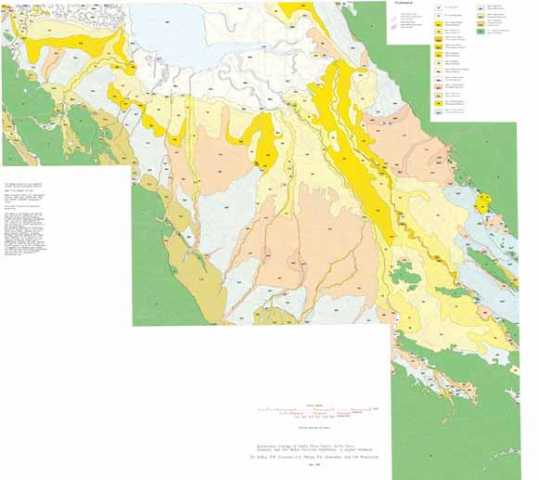
USGS website
“Geologic Map of Santa Cruz County, California”
by E.E. Babb (1989)
The following link provides an excellent zoom-able view of the geological feature map for Santa Cruz County.
USGS website
“Geologic Map of Santa Cruz County, California: U.S. Geological Survey, Miscellaneous Investigations Series Map I-1905, scale 1:62,500”
by E.E. Brabb (1989)
USGS User Guide and Overview of Resources:
“Digital Mapping Techniques '05 - Workshop Proceedings: ‘Assessing the Status of Geologic Map Coverage of the United States - A New Application of the National Geologic Map Database’”
by David R. Soller (2005)
USGS website
“Geology of the Southernmost Part of Santa Clara County, California: A Digital Database”
by R.W. Graymer (1997)
U.S. Geological Survey Open-File Report 97–710.
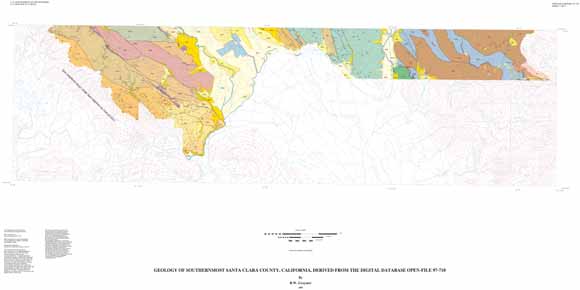
The above link provides several formats of the map as well as a data interpretation guide.
Thanks for posting this link Drew! I bought this book years ago and it was personally delivered by Fran Bennion, David’s wife. I lent it to a friend who lent it to a friend of his and never saw it again ![]() I’m glad that it available online now.
I’m glad that it available online now.
That would make me so angry! I am very protective (and possessive) of my books.
I think there are still some unfinished parts in the transcription of the various Bennion texts.
Sullivan said there’s loads. A lot are on obsolete computer disks (or tapes?). I’d like to see an update with contemporary figures. The trust has the budget. It looked like it was going to happen a decade ago, but nothing happened.
Bummer that you never got your book back, Sean. I was told a number of years ago that if you loan a book to anyone, don’t expect to ever see it again. That has been the case too many times for me!
Santa Cruz Mountains and Santa Clara Valley Wines Blog
“Two Older Santa Clara Labels”
by Dave
May 9, 2010
"Here’s a couple of interesting older labels from the Santa Clara Valley. They were opened at a recent party by Wes Barton, who has a great knack for finding interesting local wines. I didn’t get the chance to take proper notes, but I managed to rescue the empty bottles and remove the labels.
"Congress Springs was founded in the 1970’s by Daniel Gers. He discovered a derelict vineyard in Saratoga with head pruned Zinfandel vines dating back to before prohibition. Together with his wife Robin they restored the vineyards and launched a successful winery. Around 1990 Daniel sold the winery and it became Savannah-Chanelle winery. The head-pruned Zinfandel vines are still producing today.
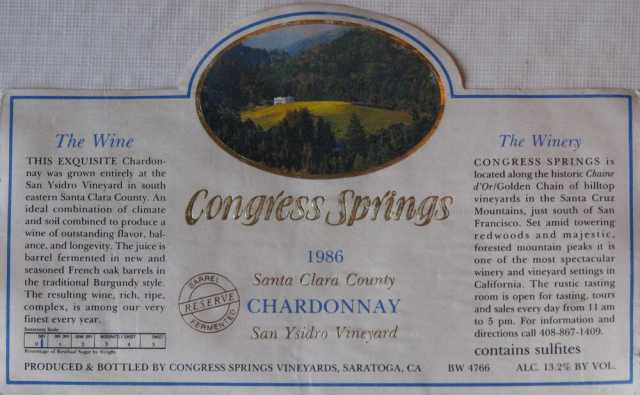
"Congress Springs was well known for their San Ysidro Chardonnay, which often gained 90+ ratings from Spectator. The wine was still in very good shape despite its age; an amber colour and nice mature flavours.
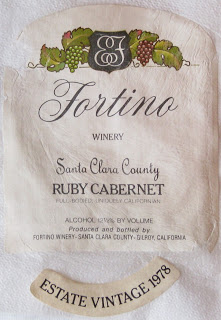
"Fortino was established in 1970 in Santa Clara’s Hecker Pass, and is still going 40 years later. They make around 15,000 cases, mainly sold from the tasting rooms and local stores and restaurants.
"Ruby Cabernet is a cross developed at UC Davis in the 1930’s. The aim was to to produce a vine combining the quality of Cabernet Sauvignon with the heat and drought tolerance of Carignan. An acre was planted at Ridge in the 1950’s, and the winery produced a series of rather good Monte Bello Ruby Cabernets from the late 1960’s through the mid 1980’s, but overall it wasn’t a great success and is now mainly planted in the Central Valley, where around 6,000 acres are grown as a blending grape for bulk wines.
“So a 30-year-old wine made from an unremarkable grape by an unremarkable winery? It turned out to be surprisingly pleasant, still having a fair amount of fruit left as well as a little tannin. The colour was a nice red brown.”
I do not know much about the quality or of the style of today’s wines from Savannah-Chanelle and Fortino. I have wondered about the old-vine Zinfandel plot on the estate of Savannah-Chanelle and the +80-year-old Carignan vines at Fortino. Now I am curious as to the fate of the Monte Bello Ruby Cabernet vineyard owned by Ridge Vineyards.
The following 1987 article provides a good overview of the wines available at the time from Gehr’s Congress Springs and, if I can say, an almost humorous retrospective on the wine trends of the mid-to-late-1980’s.
LA Times
“A Historic Winery Bucks the Trend : Dan Gehrs Revives Congress Springs Venture at Saratoga”
by Nathan Chroman
February 12, 1987
"When Dan Gehrs, a former tour guide for Paul Masson Winery, revived the old Congress Springs Winery of 1892, little did he realize that it would become the largest wine enterprise in the historic Santa Clara County town of Saratoga. With an annual production of 7,000 to 8,000 cases, he now produces more wine there than anyone, including current producers of such pioneer labels as Paul Masson and Martin Ray.
"‘No question about it I’m in love with these lovely foothills, even though the old top producers have gone,’ Gehrs said. ‘I hope my wines not only will revive my label, but the region, too, which I believe still produces some of California’s best Cabernet, Zinfandel and Chardonnay.’
"…Marvelously stylized is Zinfandel, 1984, Congress Springs, a wine from the Santa Cruz Mountains’ Chaine d’Or district. The beauty of this wine is its appealing, early drinkability, although it has the ability to age. This is a claret-styled Zinfandel that is round and flavorful with a spectacular spicy, Zinfandel nose. Made from low-yield 74-year-old vines, it is very rich and generous, with unobtrusive 13.4% alcohol and features a nice blend of 90% Zinfandel, 4% Carignane and 1% Grenache grapes. Considering the quality, it is inexpensive at $10.
"Bucking the Trend
"I asked Gehrs why he is making red Zinfandel while many other vintners are getting rich on white Zinfandels. ‘My passions as a wine lover are not aroused by white Zins, and it seems I will always feel this way,’ Gehrs said. 'No matter what the fashions are, I will want to make a red Zinfandel. I also refrained from making a late harvest type when that seemed to be in vogue.’
"Bucking the trend seems to come quite naturally to Gehrs. A prime example is Cabernet Franc, 1984, Santa Cruz Mountains, Chaine d’Or, from old vines which were retrained in a three-acre vineyard. Very few California vintners produce Cabernet Franc as a varietal, but based upon the success of this wine, more may be in the offing. This is a big wine, with greater density and texture than the Zinfandel, not unlike that found in Pomerol with outstanding forward opulence. Blended with 25% Cabernet Sauvignon, there is good backbone and structure, suggesting long-term aging possibilities.
"‘I am very fond of the Cabernet Franc grape,’ Gehrs said, ‘because of the unique varietal character, which in its youth resembles ripe black cherries, with a hint of black peppercorns. I also like how it seems to fit with toasty oak, from its 20 months aging in 4- to 5-year-old 60-gallon French oak, freshly shaved and retoasted.’ A fine change of pace red at $12.
"Another trend deviation is Pinot Blanc, 1985, which could well be a style-setter for the variety. This has Chardonnay character, buttery rich, although without any barrel fermentation, in a soft appealing style. Blind tasted, it could well be mistaken for a Chardonnay, especially with its somewhat intrusive 13.2% alcohol and wood tones from eight months of barrel aging in 60-gallon French oak.
"A Personal Pinnacle
"‘To me, this wine represents a personal pinnacle in the production of this oftentimes difficult variety,’ Gehrs said. ‘We succeeded here because the grapes are from two vineyards that have married well, that is 70% from St. Charles, Santa Cruz Mountains Vineyard, and 30% from the San Ysidro, Santa Clara Valley Vineyard.’
"In the overall scheme of white wine making, California has used this variety for sparkling wines and for filling in when more expensive Chardonnay grapes were not as abundant as now. In earlier days, the Pinot Blanc was often referred to as the ‘poor man’s Chardonnay’ with many wineries producing it as a convenient alternative to higher-priced Chardonnay. Expect this wine to age for at least three years, but it is good drinking now at $8.25.
"…Also from the San Ysidro Vineyard is Chardonnay, 1985, representing Gehrs’ fourth vintage there. An unassertive, tropical fruit-like nose and taste is featured in this big-structured, lean, long-to-age wine. There is considerable fruit here and a bit of heat in the finish from 13% alcohol. This is a superior Chardonnay from a superior vineyard and harvest, 1985. Gehrs accurately describes the wine’s finish as lemony, tart, crisp and with a butterscotch-cream smoothness. The style may not be for everyone but it’s a good beginning, at the price of $12.
"An even better Chardonnay, in a leaner, more austere style, definitely suggestive of the old Martin Ray days, is Chardonnay, 1985, from Gehrs’ own estate at Saratoga. This is a superb Chardonnay, which, although lean, is rich without being oppressive. There is greater complexity here, and because of the overall quality the $20 tab appears justified.
"Chardonnay Clone
"The wine’s quality may be partly due to a Chardonnay clone known as Mt. Eden, whose origins date to Paul Masson’s tour of France in 1898 to obtain vine cuttings from his old friend Louis Jadot, the noted negociant from the estate of Corton Charlemagne. The clone was used by both Masson and Ray. Gehrs’ estate vineyards, planted in 1977, are just beginning to mature nicely. Santa Clara has a long history with Pinot Noir, too, a fact not overlooked by Gehrs. He does not appreciate the negative comments generally directed to Pinot Noir and feels there is more said and written about the difficulties and problems of California Pinot Noir than about its pleasures and virtues.
"‘Let’s positively talk and taste Pinot Noir,’ he said. Pinot Noir, 1985, Congress Springs, produced 72% from the Santa Clara Valley Vineyards and 28% from Santa Cruz Mountain, is the kind of wine that merits positive talk. This is a big, powerfully structured, yet elegant Pinot Noir that competes well with top California and Oregon Pinot Noirs. It is reasonably priced at $12.
"Gehrs claims that production techniques used to make his Pinot Noir are grounded in awareness of the classic Burgundy method of pigeage , that is, whole cluster fermentation, mixed bodily in the fermenter. Whereas the Burgundians reportedly perform this maneuver in the buff, Gehrs’ objective is a gentle treatment of the wine from crushing through bottling.
“Now that Gehrs is the largest wine-making enterprise at Saratoga, he feels a responsibility to maintain the high quality levels of his pioneer predecessors. Gehrs said, ‘I guess I am making wine and continuing tradition at the same time.’”
That’s Dave Tong’s old wine blog. Geez, seems like I haven’t seen him since…yesterday.
Iirc, that last vintage of the Monte Bello Ruby Cab was '84. Oldest I ever saw was the '68, which was quite good (part of the price of admission for me to weasel in on a Gong of Pour tour with Paul Draper). Have attended a vertical tasting of these, as well as tasting an odd one here and there. I’d say about one out of three vintages aged well, and weren’t far below Monte Bello in quality. The rest were weird, with a sort of paste-y muck and sweet Red Vines.
Thanks, Wes!!
I am assuming that the Monte Bello land is of prime value to the Ridge folks, so the Ruby Cabernet vines probably have been ripped out…?
